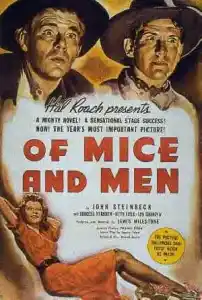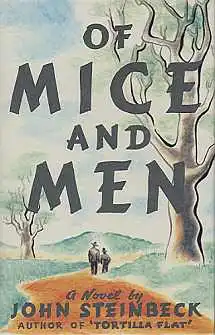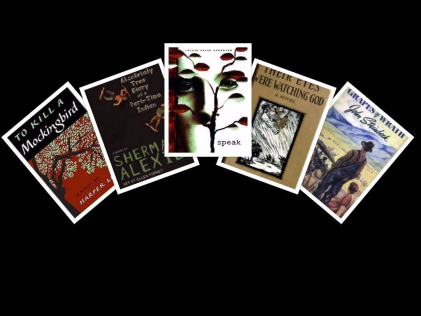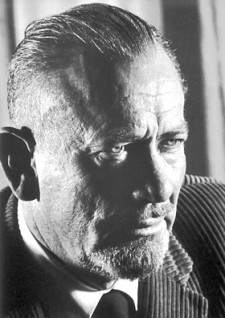
Fig 1. Book Cover (Wikipedia.org)
November 15, 2016
By Pranav Bohra and Soor Vora
An American Classic is challenged across the country…

Fig 2. Book cover (Wikipedia.org)
Who: John Steinbeck
What: Of Mice and Men
Where: The United States Of America
When: 1937
Why: Profanity, racism, and violence
“Yes, books are dangerous. They should be dangerous – they contain ideas.”
John Steinbeck’s novel Of Mice and Men, published in 1937, recounts the experience of two migrant workers who travel across California to find new jobs during the Great Depression. The main characters of the book are George Milton and Lennie Small. Lennie possesses great physical strength but suffers from a mental disability. On the other hand, George is intelligent but uneducated. The book depicts their experiences traveling to a ranch and their numerous interactions. In the process, they meet Curley, a rash, rugged worker. Lennie’s innocence leads him to accidentally kill his puppy and Curley’s wife. Curley begins to pursue them, leading George to have no choice but to kill Lennie for his own good.
As acclaimed as the book is, it is drenched in controversial elements that have resulted in its censorship in American high schools. Even recently, in the 2000s, the book has undergone challenges to remove it from curricula. Indeed, Of Mice and Men was recognized as one of the most challenged books of the 21st century in 2004 by the American Library Association (ALA).
The main reasons for challenging the book are profanity, violence, racist language, and euthanasia. The Great Depression was one of the most catastrophic events in American history, and Steinbeck, through his novel, depicts the life of the common masses at that time, adopting vulgar phrases and words that were the vernacular of the time including words like, D–n, h—, b–tard, b–ch and son of a b—ch. Nonetheless, some of this lexicon has been seen as offensive and inappropriate for students.
Another reason the novel is challenged is for its representation of racism. The character of Crooks, for example, serves as an African-American character working in the stables at a ranch. While all other workers were allowed to play games and talk the way they wanted, Crooks was not allowed to participate in any game or activity. Rather, he was looked down upon. In addition, Crooks is given an isolated shack, separating him from everyone else. This segregation made him lonely and bitter toward the rest of the workers.
An additional reason the book was challenged was that some people feel that it promotes euthanasia. By definition, euthanasia is “the act of putting one to death painlessly or allowing one to die, as by withholding extreme medical measures, a person or animal suffering from an incurable, especially a painful, disease or condition” (Collins English Dictionary). In Of Mice and Men, there are two incidents that can be seen as incidents of mercy killing. The first is when Carlson kills Candy’s old dog. The dog was going to die of old age; it had a painful disease that caused it angst. By killing it, Carlson ended its misery and saved it from more suffering. The second is when George kills Lennie. After Lennie kills Curley’s wife, he goes into hiding. George finds him and shoots him, giving him a much less painful death. George knew that Curley would not forgive Lennie and would have tortured him to death. George pulls the trigger out of love for Lennie; for he does not want him to suffer any more in life, given Lennie’s mental disability (Steinbeck).
Fig 3.Of Mice and Men Movie.(Youtube)
Because of these themes, Of Mice and Men has been one of the most challenged books of all time, particularly in secondary education settings. According to Beverly Goldberg, in George County, Missouri, the book was banned in 2004 because “the school has a policy against students using profanity” (Goldberg). In Idaho, the book barely survived a censorship attempt in which the case was taken all the way to a school board (Schaub). In both situations, the role of parents was prominent. One of the justifications for banning Of Mice and Men in George County was that “the parents need the opportunity to say they don’t want their child to read the book” (Goldberg). A board member in favor of the Idaho ban argued, “I have worked to get this district to be more accountable to parents” (Schaub), showing how the district felt it necessary to get the approval of its citizens.
New York’s Fayetteville-Manlius High School (F-M) does use Of Mice and Men in its English Curriculum. F-M English Teacher, Kari Hammond, justified the use of the novel in a personal interview. She asserts that “Steinbeck is an expert at writing with detail and imagery, of course, but he also writes the characters of George and Lennie as close to authentic as possible.” She emphasizes that Steinbeck’s effective writing and literary elements give the book its value.

Fig 4. Collage of Banned Books (Wikipedia.org)
Because high school students are a unique population, strong consideration of course materials is essential. For instance, Laurie Halse Anderson’s Speak is censored in high schools because of its sexual depictions. Wesley Scroggins, an associate professor at Missouri State University, characterized it as “soft porn” (HLR 250). A middle school introduced an edited version of Fahrenheit 451 with no profanity (Ha). A Virginia High School banned Zora Neale Hurston’s Their Eyes were watching God due to language and sexual content (Ha). Sherman Alexie’s The Absolutely True Diary of A Part-Time Indian was censored due to its depiction of drug use, alcohol, and gambling (Ha). These examples show a pattern of an apparent focus on character and keeping bad deeds and influences away from students. There are also some examples of books being censored in high schools due to societal viewpoints. Marjane Satrapi’s Persepolis is censored due to its political viewpoints on Islamic Fundamentalism and the Iran-Iraq war (Ha). Thus, elements like profanity and sexual content, as well as violence and politics, are factors that separate banned books in the public sphere and banned books in the high school sphere.

Figure 5: John Steinbeck (Wikipedia.org)
However, these factors are of particular concern because of the age of high school students. John Farley pointed out that Nassau High School censored books because of “The youth and immaturity of high school students” and the fact that they have “ill effects on character and conduct.” Farley reveals that there is a belief that high school students do not yet have the maturity to handle sensitive material. Therefore, such exposure could change them for the worse, and if the content is taught in a school setting, could negatively affect student behavior.
Pat Scales argues for the importance of teaching difficult texts in her article “Studying the First Amendment.” She asserts that these books need to be covered because “students who read learn to think” (Scales). With this, she defends the importance of the lessons books can impart to students. The aforementioned F-M district has an English Department that frequently and deliberately uses challenged books. In Laurie Halse Anderson’s Speak, the sexual references are the ones that need addressing. Hammond contends that Melinda’s social experience and “how talking to someone and connecting with someone has helped empower her and make a shift in her character’s life” should be the focus of the class’s conversation. In Alexie’s The Absolutely True Diary of a Part-Time Indian, the scenes depicting gambling, drinking, and masturbation are controversial, but by focusing on “Alexie’s brilliant portrayal of teenage life and sexuality,” Hammond re-interprets the controversial elements in an educative way. With Of Mice And Men, Hammond uses the profanity to discuss intentionality of writing and encourages students to “think about why the author has made the decision to include it.” Steinbeck has used violence, racism, and profanity to build a context and give the readers an authentic picture of the 30s. These not only add to the aesthetics of the characters, but better depict emotions like the frustration of the ranch worker.
Trent Lorcher’s English syllabus from his Nevada high school provides a good example of how students can learn analytical skills by reading such books. In Of Mice and Men, students learn to understand literary techniques such as “characterization,” “circular plot,” and “setting,” among others (Lorcher). In addition to literary techniques, students also learn about some of the contextual elements and lessons present in the text. One of these is the Great Depression and the “treatment of the mentally handicapped,” based on the way George interacts with Lennie (Lorcher). Lorcher’s descriptions show that controversial books such as Of Mice and Men enable students to activate new critical and contextual skills.
The censorship of Of Mice and Men and other controversial books can be reduced to a conflict between the need to protect students from harmful elements and the constructive value of these books. Due to students’ ages, the criteria for banning books is complex, and this decision of whether or not to censor ends up having a large impact on their academic and intellectual development.
Key words: Of Mice and Men, censorship, profanity, high school, pedagogy, Steinbeck, age group, contextual elements
Works Cited
“Banned And/or Challenged Books from the Radcliffe Publishing Course Top 100 Novels of the 20th Century.” Banned & Challenged Books. American Library Association, 23 May 2013. Web. 08 Nov. 2016.
Farley, John J. “Book Censorship in the Senior High School Libraries of Nassau County, New York.” Order No. 6500969 New York University, 1964. Ann Arbor: ProQuest. Web. 8 Nov. 2016.
Goldberg, Beverly. “Of Mice and Mississippi.” American Libraries 34.2 (2003): 17. ProQuest. Web. 8 Nov. 2016.
Ha, Thu-Huong. “These Are the Top 10 Books Americans Tried to Ban Last Year.” Quartz. N.p., 27 Sept. 2015. Web. 08 Nov. 2016.
Hammond, Kari. An Interview With Kari Hammond. November 2nd, 2016. Web.
HLR250. “Speak, Laurie Halse Anderson.” Censorship Young Adult Literature. N.p., 29 Nov. 2013. Web. 08 Nov. 2016.
Lorcher, Trent. “Standards-Based Curriculum Map: Freshman English Syllabus: A Curriculum Guide for Language Arts.” Bright Hub Education. N.p., 18 Feb. 2014. Web. 08 Nov. 2016.
Scales, Pat. “Studying the First Amendment.” Knowledge Quest 28.3 (2000): 28.ProQuest. Web. 8 Nov. 2016.
Steinbeck, John. Of Mice and Men. New York, N.Y., U.S.A: Penguin Books, 1994. Print.
“Top 100 Banned/Challenged Books: 2000-2009.” Banned & Challenged Books. American Library Association, 26 Mar. 2013. Web. 08 Nov. 2016.
